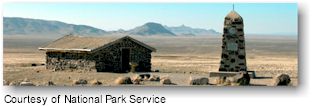|
 The Pony Express National Historic Trail was used by young men on fast paced horses to carry the nation's mail across the country, from St. Joseph, Missouri to Sacramento, California, in the unprecedented time of only ten days. Organized by private entrepreneurs, the horse-and-rider relay system became the nation's most direct and practical means of east-west communications before the telegraph. Though only in operation for 18 months, between April 1860 and October 1861, the trail proved the feasibility of a central overland transportation route, and played a vital role in aligning California with the Union in the years just before the Civil War. The Pony Express National Historic Trail was used by young men on fast paced horses to carry the nation's mail across the country, from St. Joseph, Missouri to Sacramento, California, in the unprecedented time of only ten days. Organized by private entrepreneurs, the horse-and-rider relay system became the nation's most direct and practical means of east-west communications before the telegraph. Though only in operation for 18 months, between April 1860 and October 1861, the trail proved the feasibility of a central overland transportation route, and played a vital role in aligning California with the Union in the years just before the Civil War.
Most of the original trail has been obliterated either by time or human activities. Along many segments, the trail's actual route and exact length are matters of conjecture. However, approximately 120 historic sites may eventually be available to the public, including 50 existing Pony Express stations or station ruins.
There are a number of ways to enjoy the Pony Express National Historic Trail, including auto-touring, visiting interpretive sites, hiking, biking or horseback riding trail segments, and visiting museums. Depending on which segment you would like to explore, some or all of these activities may be available.
Getting There:
A Pony
Express Map is available from the National Park Service with
directions for following the Pony Express NHT by automobile.
An
Auto Tour Route Interpretive Guide can
also be downloaded from the National Park Service for the Western Missouri and Northeastern Kansas region. The guide provides information about historic trail sites and points of interest along the Oregon, California, and Pony Express National Historic Trails.
|



